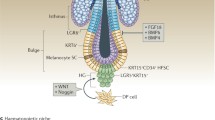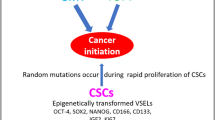Abstract
What is now familiarly referred to as the ‘embryonic stem (ES) cell’ is a recent biological category whose origins lie in research into benign and malignant teratomas carried out in the 1950s, 60s and 70s. In these studies, the question of the normal or pathological character of the ES cell was a matter of considerable debate and indeed the term ES cell was often used interchangeably with that of the embryonal carcinoma (EC) cell. This article argues that the indecisiveness of the entity known as the ES cell—its refusal to commit to established demarcations between the normal and the pathological—continues to haunt the field of stem cell science. Exploring the prehistory of research into ES cells, early theories of cancer (in particular the embryonal theory expounded by Julius Cohnheim) and recent theoretical critiques of the somatic mutation theory, the article not only points to a shift in understandings of the normal and the pathological but asks under what conditions such shifts are able to take place.
Similar content being viewed by others
Notes
This is not to say that teratocarcinoma research is the only thread in the complex history of contemporary stem cell research. See Brown et al. [8] for a fascinating and detailed history of research into hematopoetic stem cells, the first stem cells to be successfully used in therapeutic treatments. See also Edwards [16] who claims that ES cells belong to the history of human in-vitro fertilization and chimaera research dating from the sixties. A pioneer in IVF research, R. G. Edwards was speculating about the therapeutic potential of ES cells from as early as 1982. For detailed scientific reviews outlining the history of teratocarcinoma research I am following here, see Andrews [3], Damjanov [14] and Papaioannou [28].
See the articles of Brinster [7], Papaioannou et al. [29] and Mintz and Illmensee [25]. In these experiments, EC cells derived from tumours were transplanted into blastocysts and then reimplanted into the uterus of female mice. The EC cells appeared to participate in the normal process of embryonic development.
Although it must be said that the question is beginning to be asked more pointedly as adult and embryonic stem cell therapies move into clinical trial. The possibility of teratoma-formation and the uncertainties of ES cell behaviour are of particular concern for regulators attempting to define standard product specifications for these novel, and extremely lively, biologicals.
See for example the latest edition of Alberts et al. Molecular Biology of the Cell (Alberts et al. [2, pp. 1217–1219]) for a representative exposition of the “stem cell theory of cancer.”
See Barry Peirce and Speers [6] for a much longer consideration of the therapeutic possibilities suggested by teratocarcinoma research.
For a detailed history of the oncogene theory of cancer, see Fujimura [18].
See also [34, pp. 25–26, 106–107] for Soto and Sonnenschein’s critique of cell culture methods.
In Life as Surplus [13, pp. 103–128], I have explored the influence of morphogenetic fields and topological theories of transformation in contemporary tissue engineering, with a particular emphasis on the work of René Thom.
References
Alberts, Bruce, Dennis Bray, Julian Lewis, Martin Raff, Keith Roberts, and James D. Watson. 1983. Molecular biology of the cell, 2nd ed. New York and London: Garland Publishing.
Alberts, Bruce, Dennis Bray, Julian Lewis, Martin Raff, Keith Roberts, and James D. Watson. 2008. Molecular biology of the cell, 5th ed. New York: Garland Publishing.
Andrews, Peter W. 2002. From teratocarcinomas to embryonic stem cells. Philosophical Transactions of the Royal Society of London B 357: 405–417.
Askanazy, M. 1907. Die Teratome nach ihrem Bau, ihrem Verlauf, ihrer Genese und im Vergleich zum Experimentellen Teratoid. Verhandl Deut Ges Pathol 11: 39–82.
Barry Pierce, G. 1968. Teratocarcinoma: Model for a developmental concept of cancer. Current Topics in Developmental Biology 2: 223–246.
Barry Pierce, G., and Wendell C. Speers. 1988. Tumors as caricatures of the process of tissue renewal: Prospects for therapy by directing differentiation. Perspectives in Cancer Research 48: 1996–2004.
Brinster, R.L. 1974. The effect of cells transferred into the mouse blastocyst on subsequent development. Journal of Experimental Medicine 140: 1049–1056.
Brown, Nik, Alison Kraft, and Paul Martin. 2006. The promissory pasts of blood stem cells. BioSocieties 1: 329–348.
Canguilhem, George. 1989. The normal and the pathological. New York: Zone Books.
Canguilhem, George. 1994. A vital rationalist: Selected writings from Georges Canguilhem. (edited and trans: Paul Rabinow). New York: Zone Books.
Chaplain, M.A.J., J.D. Singh, and J.C. McLachlan. 1999. On growth and form: Spatiotemporal pattern formation in biology. Chichester: Wiley.
Cohnheim, Julius. 1877(1882). Vorlesungen über allgemeine Pathologie (Erster Band), 2d edn. Berlin: Hirschwald.
Cooper, Melinda. 2008. Life as surplus: Biotechnology and capitalism in the neoliberal era. Seattle: Washington University Press.
Damjanov, Ivan. 1993. Teratocarcinoma: Neoplastic lessons about normal embryogenesis. International Journal of Developmental Biology 37: 39–46.
Damjanov, Ivan, and Davor Solter. 1974. Experimental teratoma. Current Topics in Pathology 59: 69–130.
Edwards, R.G. 2001. IVF and the history of stem cells. Nature 413: 349–351.
Evans, M.J., and M.H. Kaufman. 1981. Establishment in culture of pluripotential cells from mouse embryos. Nature 292: 154–156.
Fujimura, Joan H. 1996. Crafting science: A sociohistory of the quest for the genetics of cancer. Cambridge, MA: Harvard University Press.
Hogle, Linda. 2003. Life/time warranty: Rechargeable cells and extendable life. In Remaking life and death: Toward an anthropology of the biosciences, ed. S. Franklin, and M. Lock, 61–96. Santa Fe, NM: School of American Research Press.
Kim, Jong Bin. 2005. Review: Three-dimensional tissue culture models in cancer biology. Seminars in Cancer Biology 15: 365–377.
Landecker, Hannah. 2005. Living differently in time: Plasticity, temporality and cellular biotechnologies. Culture Machine. URL http://culturemachine.tees.ac.uk/Cmach/Backissues/j007/article/landecker.htm.
Lenoir, Timothy. 1982. The strategy of life: Teleology and mechanics in nineteenth century German biology. London: D. Reidel Publishing.
Martin, G.R. 1981. Isolation of a pluripotent cell line from early mouse embryos cultured in medium conditioned by teratocarcinoma stem cells. Proceedings of the National Academy of Science USA 78: 7634–7636.
Minot, Charles S. 1908. The problem of age, growth, and death. London: John Murray.
Mintz, B., and K. Illmensee. 1975. Normal genetically mosaic mice produced from malignant teratocarcinoma cells. Proceedings of the National Academy of Science USA 72:3585–3589.
Morange, Michel. 2000. A history of molecular biology (trans: Matthew Cobb). Cambridge, MA: Harvard University Press.
Müller, Johannes. 1838. Über den feinern Bau und die Formen der krankhaften Geschwülste. Berlin: G. Reimer.
Papaioannou, Virginia E. 1993. Ontogeny, pathology, oncology. International Journal of Developmental Biology 37: 33–37.
Papaioannou, V.E., M.W. McBurney, R.L. Gardner, and M.J. Evans. 1975. Fate of teratocarcinoma cells injected into early mouse embryos. Nature 258: 70–73.
Rather, L.J. 1978. The genesis of cancer: A study in the history of ideas. Baltimore: Johns Hopkins University Press.
Rather, L.J. 1986. Johannes Muller and the nineteenth-century origins of tumor cell theory. Canton, MA: Science History Publications.
Sitharama Iyengar, S. (ed.). 1998. Computer modeling and simulations of complex biological systems. Boca Raton, Fla: CRC Press.
Solter, D., N. Skreb, and I. Damjanov. 1970. Extra-uterine growth of mouse egg-cylinders results in malignant teratoma. Nature 227: 503–504.
Sonnenschein, C., and A.M. Soto. 1999. The society of cells: Cancer and control of cell proliferation. New York: Springer.
Stevens, Leroy C. 1970. The development of transplantable teratocarcinoma from intratesticular grafts of pre- and postimplantation mouse embryos. Developmental Biology 21: 364–382.
Sun, Wei, Andrew Darling, Binil Starly, and Jae Nam. 2004. Computer-aided tissue engineering: Overview, scope and challenges (review). Biotechnological Applications in Biochemistry 39: 29–47.
Sun, Wei, Binil Starly, Andrew Darling, and Connie Gomez. 2004. Computer-aided tissue engineering: Application to biomimetic modelling and design of tissue scaffolds. Biotechnological Applications in Biochemistry 39: 49–58.
Thomson, J.A., J. Istkovitz-Elder, S.S. Shapiro, M.A. Waknitz, J.J. Swiergel, V.S. Marshall, and J.M. Jones. 1998. Embryonic stem cell lines derived from human blastocysts. Science 282: 1145–1147.
Virchow, Rudolf. 1860. Cellular pathology as based upon physiological and pathological histology. Translated from the second edition of the original by Frank Chance. London: John Churchill.
Virchow, Rudolf. 1880. Krankheitswesen und Krankheitsursachen. Archiv fur pathologische Anatomie und Physiologie und fur klinische Medicin 79: 1–19. 185–228.
Author information
Authors and Affiliations
Corresponding author
Rights and permissions
About this article
Cite this article
Cooper, M. Regenerative Pathologies: Stem Cells, Teratomas and Theories of Cancer. Medicine Studies 1, 55–66 (2009). https://doi.org/10.1007/s12376-008-0002-4
Received:
Accepted:
Published:
Issue Date:
DOI: https://doi.org/10.1007/s12376-008-0002-4




